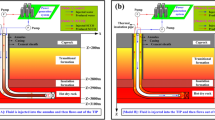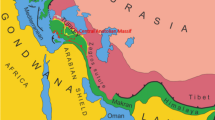Abstract
The utilization of geothermal energy is clean and has great potential worldwide, and it is important to utilize geothermal energy in a sustainable manner. Mathematical modeling studies of geothermal reservoirs are important as they evaluate and quantify the complex multi-physical effects in geothermal reservoirs. However, previous modeling efforts lack the study focusing on the emission reduction efficiency and the deformation at geothermal wellbores caused by geothermal water extraction/circulation. Emission efficiency is rather relevant in geothermal projects introduced in areas characterized by elevated air pollution where the utilization of geothermal energy is as an alternative to burning fossil fuels. Deformation at geothermal wellbores is also relevant as significant deformation caused by water extraction can lead to geothermal wellbore instability and can consequently decrease the effectiveness of the heat extraction process in geothermal wells. In this study, the efficiency of emission reduction and heat extraction in a sedimentary geothermal reservoir in Daming County, China, are numerically investigated based on a coupled multi-physical model. Relationships between the efficiency of emission reduction and heat extraction, deformation at geothermal well locations, and geothermal field parameters including well spacing, heat production rate, re-injection temperature, rock stiffness, and geothermal well placement patterns are analyzed. Results show that, although large heat production rates and low re-injection temperatures can lead to decreased heat production in the last 8 years of heat extraction, they still improve the overall heat production capacity and emission reduction capacity. Also, the emission reduction capacity is positively correlated with the heat production capacity. Deformation at geothermal wellbore locations is alleviated by smaller well spacing, lower heat production rates, and smaller numbers of injectors in the well pattern, and by placing wells at locations with higher rock stiffness. Compared with the reference case with coal burning for heating purposes, the yearly emission reduction capacity can reach 1 × 107 kg by switching to the direct utilization of geothermal energy in Daming field.













Similar content being viewed by others

References
An Q, Wang Y, Zhao J, Luo C, Wang Y (2016) Direct utilization status and power generation potential of low-medium temperature hydrothermal geothermal resources in Tianjin, China: a review. Geothermics 64:426–438. https://doi.org/10.1016/j.geothermics.2016.06.005
Atkins MJ, Morrison AS, Walmsley MR (2010) Carbon emissions pinch analysis (CEPA) for emissions reduction in the New Zealand electricity sector. Appl Energy 87(3):982–987. https://doi.org/10.1016/j.apenergy.2009.09.002
Barton CA, Zoback MD, Burns KL (1988) In-situ stress orientation and magnitude at the Fenton Geothermal Site, New Mexico determined from wellbore breakouts. Geophys Res Lett 15(5):467–470. https://doi.org/10.1029/GL015i005p00467
Bassiouni Z (1994) Theory, measurement, and interpretation of well logs. Society of Petroleum Engineers, Richardson
Biot MA (1941) General theory of three-dimensional consolidation. J Appl Phys 12(2):155–164. https://doi.org/10.1063/1.1712886
Blöcher MG, Zimmermann G, Moeck I, Brandt W, Hassanzadegan A, Magri F (2010) 3D numerical modeling of hydrothermal processes during the lifetime of a deep geothermal reservoir. Geofluids 10(3):406–421. https://doi.org/10.1111/j.1468-8123.2010.00284.x
Bloomfield KK, Moore JN, Neilson RM (2003) Geothermal energy reduces greenhouse gases. Bull Geotherm Resour Counc 32:77–79
Cacace M, Blöcher G, Watanabe N, Moeck I, Börsing N, Scheck-Wenderoth M, Kolditz O, Huenges E (2013) Modelling of fractured carbonate reservoirs: outline of a novel technique via a case study from the Molasse Basin, southern Bavaria, Germany. Environ Earth Sci 70(8):3585–3602. https://doi.org/10.1007/s12665-013-2402-3
Cheng WL, Wang CL, Nian YL, Han BB, Liu J (2016) Analysis of influencing factors of heat extraction from enhanced geothermal systems considering water losses. Energy 115:274–288. https://doi.org/10.1016/j.energy.2016.09.003
China National Coal Association (2013) Annual report on coal industry in China 2013. China Economic Publishing House, Beijing (in Chinese)
DigitalGlobe (2017) Daming County satellite map retrieved from Google Maps. Google. https://www.google.com/maps/@36.289542,115.13403,15z
Fox DB, Koch DL, Tester JW (2016) An analytical thermohydraulic model for discretely fractured geothermal reservoirs. Water Resour Res 52(9):6792–6817. https://doi.org/10.1002/2016WR018666
Fridleifsson IB (2001) Geothermal energy for the benefit of the people. Renew Sust Energy Rev 5(3):299–312. https://doi.org/10.1016/S1364-0321(01)00002-8
Fridleifsson IB, Bertani R, Huenges E, Lund JW, Ragnarsson A, Rybach L (2008) The possible role and contribution of geothermal energy to the mitigation of climate change. In: IPCC scoping meeting on renewable energy sources, Luebeck
Guo X, Kim J, Killough JE (2017). Hybrid MPI-OpenMP scalable parallelization for coupled non-isothermal fluid-heat flow and elastoplastic geomechanics. In: 2017 SPE Reservoir Simulation Conference, Montgomery, Texas, United States doi:https://doi.org/10.2118/182665-MS
Hicks TW, Pine RJ, Willis-Richards J, Xu S, Jupe AJ, Rodrigues NEV (1996) A hydro-thermo-mechanical numerical model for HDR geothermal reservoir evaluation. Int J Rock Mech Min Sci Geomech Abstr 33(5):499–511. https://doi.org/10.1016/0148-9062(96)00002-2
Hofmann H, Babadagli T, Yoon JS, Blöcher G, Zimmermann G (2016) A hybrid discrete/finite element modeling study of complex hydraulic fracture development for enhanced geothermal systems (EGS) in granitic basements. Geothermics 64:362–381. https://doi.org/10.1016/j.geothermics.2016.06.016
Hou Z, Gou Y, Taron J, Gorke UJ, Kolditz O (2012) Thermo-hydro-mechanical modeling of carbon dioxide injection for enhanced gas-recovery (CO2-EGR): a benchmarking study for code comparison. Environ Earth Sci 67(2):549–561. https://doi.org/10.1007/s12665-012-1703-2
Huang X, Zhu J, Li J, Lan C, Jin X (2016) Parametric study of an enhanced geothermal system based on thermo-hydro-mechanical modeling of a prospective site in Songliao Basin. Appl Therm Eng 105:1–7. https://doi.org/10.1016/j.applthermaleng.2016.05.142
Jiang G, Li W, Rao S, Shi Y, Tang X, Zhu C, Gao P, Wang Y, Hu S (2016) Heat flow, depth–temperature, and assessment of the enhanced geothermal system (EGS) resource base of continental China. Environ Earth Sci 75(22):1432. https://doi.org/10.1007/s12665-016-6238-5
Kolditz O, Bauer S, Bilke L, Böttcher N, Delfs JO, Fischer T, Görke UJ, Kalbacher T, Kosakowski G, McDermott CI, Park CH (2012) OpenGeoSys: an open-source initiative for numerical simulation of thermo-hydro-mechanical/chemical (THM/C) processes in porous media. Environ Earth Sci 67(2):589–599. https://doi.org/10.1007/s12665-012-1546-x
Kolditz O, Shao H, Wang W, Bauer S (2015) Thermo-hydro-mechanical-chemical processes in fractured porous media: modelling and benchmarking. Springer, Berlin. https://doi.org/10.1007/978-3-319-29224-3
Kong Y, Pang Z, Shao H, Kolditz O (2017) Optimization of well-doublet placement in geothermal reservoirs using numerical simulation and economic analysis. Environ Earth Sci 76(3):118. https://doi.org/10.1007/s12665-017-6404-4
Kristmannsdóttir H, Ármannsson H (2003) Environmental aspects of geothermal energy utilization. Geothermics 32(4-6):451–461. https://doi.org/10.1016/S0375-6505(03)00052-X
Liu G, Yang Z, Chen B, Zhang Y, Su M, Ulgiati S (2016) Prevention and control policy analysis for energy-related regional pollution management in China. Appl Energy 166:292–300. https://doi.org/10.1016/j.apenergy.2015.06.032
Llanos EM, Zarrouk SJ, Hogarth RA (2015) Numerical model of the Habanero geothermal reservoir, Australia. Geothermics 53:308–319. https://doi.org/10.1016/j.geothermics.2014.07.008
Lund JW, Freeston DH, Boyd TL (2011) Direct utilization of geothermal energy 2010 worldwide review. Geothermics 40(3):159–180. https://doi.org/10.1016/j.geothermics.2011.07.004
National Research Council (2000) Cooperation in the energy futures of China and the United States. National Academies Press, Washington, D.C.
Pandey SN, Chaudhuri A, Kelkar S (2017) A coupled thermo-hydro-mechanical modeling of fracture aperture alteration and reservoir deformation during heat extraction from a geothermal reservoir. Geothermics 65:17–31. https://doi.org/10.1016/j.geothermics.2016.08.006
Peška P, Zoback MD (1995) Compressive and tensile failure of inclined well bores and determination of in situ stress and rock strength. J Geophys Res-Solid Earth 100(B7):12791–12811. https://doi.org/10.1029/95JB00319
Pruess K (1985) A practical method for modeling fluid and heat flow in fractured porous media. Soc Pet Eng J 25(01):14–26. https://doi.org/10.2118/10509-PA
Pruess K, Wu YS (1993) A new semi-analytical method for numerical simulation of fluid and heat flow in fractured reservoirs. SPE Adv Technol Ser 1(02):63–72. https://doi.org/10.2118/18426-PA
Russo SL, Boffa C, Civita MV (2009) Low-enthalpy geothermal energy: an opportunity to meet increasing energy needs and reduce CO2 and atmospheric pollutant emissions in Piemonte, Italy. Geothermics 38(2):254–262. https://doi.org/10.1016/j.geothermics.2008.07.005
Rahmati H, Jafarpour M, Azadbakht S, Nouri A, Vaziri H, Chan D, Xiao Y (2013) Review of sand production prediction models. J Pet Eng 2013:1–16. https://doi.org/10.1155/2013/864981
Self SJ, Reddy BV, Rosen MA (2013) Geothermal heat pump systems: status review and comparison with other heating options. Appl Energy 101:341–348. https://doi.org/10.1016/j.apenergy.2012.01.048
Southon JN (2005) Geothermal well design, construction and failures. In: World Geothermal Congress 2005, Antalya, Turkey
Standardization Administration of China (2017) China’s coal standards. http://www.sac.gov.cn. Accessed 5 May 2017 (in Chinese)
Sun ZX, Zhang X, Xu Y, Yao J, Wang HX, Lv S, Sun ZL, Huang Y, Cai MY, Huang X (2017) Numerical simulation of the heat extraction in EGS with thermal-hydraulic-mechanical coupling method based on discrete fractures model. Energy 120:20–33. https://doi.org/10.1016/j.energy.2016.10.046
Tong F, Jing L, Zimmerman RW (2009) An effective thermal conductivity model of geological porous media for coupled thermo-hydro-mechanical systems with multiphase flow. Int J Rock Mech Min Sci 46(8):1358–1369. https://doi.org/10.1016/j.ijrmms.2009.04.010
Troiano A, Di Giuseppe MG, Monetti A, Patella D, Troise C, De Natale G (2017) Fluid injection in enhanced geothermal systems: a study on the detectability of self-potential effects and on their correlation with induced seismicity. Geothermics 65:280–294. https://doi.org/10.1016/j.geothermics.2016.05.003
Turali EY, Simsek S (2017) Conceptual and 3D simulation modeling of the Sorgun hydrothermal reservoir (Yozgat, Turkey). Geothermics 66:85–100. https://doi.org/10.1016/j.geothermics.2016.11.012
Volpi G, Crosta GB, Colucci F, Fischer T, Magri F (2017) Numerical simulations of highly buoyant flows in the Castel Giorgio-Torre Alfina deep geothermal reservoir. In: EGU General Assembly Conference 2017, Vienna
Wang SY, Yao L, Liu ZR, Ji DS, Wang LL, Zhang JK (2013) Formation of haze pollution in Beijing–Tianjin–Hebei region and their control strategies. Bull Chin Acad Sci 10:353–363 (In Chinese)
Wang S, Huang Z, YS W, Winterfeld PH, Zerpa LE (2016) A semi-analytical correlation of thermal-hydraulic-mechanical behavior of fractures and its application to modeling reservoir scale cold water injection problems in enhanced geothermal reservoirs. Geothermics 64:81–95. https://doi.org/10.1016/j.geothermics.2016.04.005
Watanabe N, Blöcher G, Cacace M, Held S, Kohl T (2016) Geoenergy modeling III: enhanced geothermal systems. Spring. https://doi.org/10.1007/978-3-319-46581-4
Xia Y, Plummer M, Mattson E, Podgorney R, Ghassemi A (2017) Design, modeling, and evaluation of a doublet heat extraction model in enhanced geothermal systems. Renew Energy 105:232–247. https://doi.org/10.1016/j.renene.2016.12.064
Xu B, Li M, Pi X (2016) Sustainable development of geothermal industry in China: an overview. In: 2016 Asia Conference on Power and Electrical Engineering. doi:https://doi.org/10.1051/matecconf/20165506008
Yang SY, Yeh HD (2009) Modeling heat extraction from hot dry rock in a multi-well system. Appl Therm Eng 29(8):1676–1681. https://doi.org/10.1016/j.applthermaleng.2008.07.020
Yue GF, Lv WB, Zhang W, Ran SU, Lin WJ (2016) Optimization of geothermal water exploitation in Xinji, Hebei Province, PR China. J Groundw Sci Eng 4:197–203
Zeng Y, Zhan J, Wu N, Luo Y, Cai W (2016) Numerical investigation of electricity generation potential from fractured granite reservoir by water circulating through three horizontal wells at Yangbajing geothermal field. Appl Therm Eng 104:1–15. https://doi.org/10.1016/j.applthermaleng.2016.03.148
Zhang FZ, Jiang PX, Xu RN (2013) System thermodynamic performance comparison of CO2-EGS and water-EGS systems. Appl Therm Eng 61(2):236–244. https://doi.org/10.1016/j.applthermaleng.2013.08.007
Zhao XG, Wan G (2014) Current situation and prospect of China’s geothermal resources. Renew Sust Energy Rev 32:651–661. https://doi.org/10.1016/j.rser.2014.01.057
Acknowledgments
The authors express gratitude to Sinopec Star Petroleum Co., Ltd. for the cooperation in this work.
Funding
This work was supported by the National Natural Science Foundation of China (Grant No. 51404024) and the Beijing Nova Program, Beijing, China (Grant No. Z171100001117081).
Author information
Authors and Affiliations
Corresponding author
Ethics declarations
Conflict of interest
The authors declare that they have no conflict of interest.
Additional information
Responsible editor: Marcus Schulz
Rights and permissions
About this article
Cite this article
Guo, X., Song, H., Killough, J. et al. Numerical investigation of the efficiency of emission reduction and heat extraction in a sedimentary geothermal reservoir: a case study of the Daming geothermal field in China. Environ Sci Pollut Res 25, 4690–4706 (2018). https://doi.org/10.1007/s11356-017-0845-x
Received:
Accepted:
Published:
Issue Date:
DOI: https://doi.org/10.1007/s11356-017-0845-x



